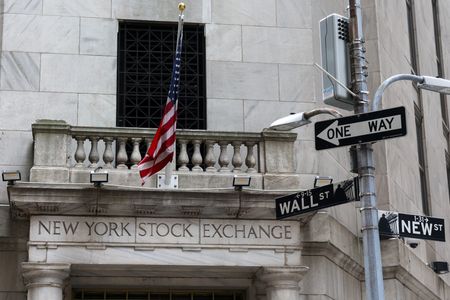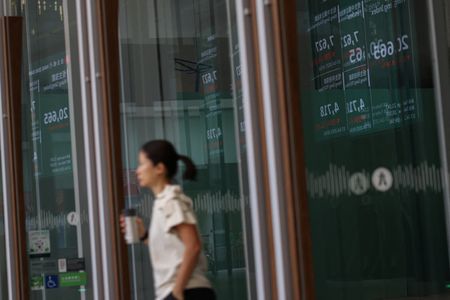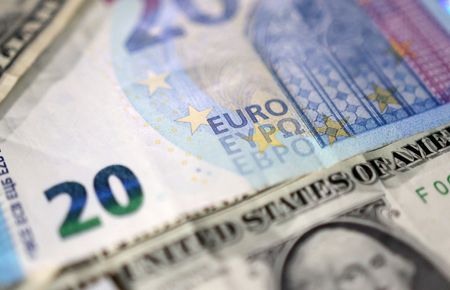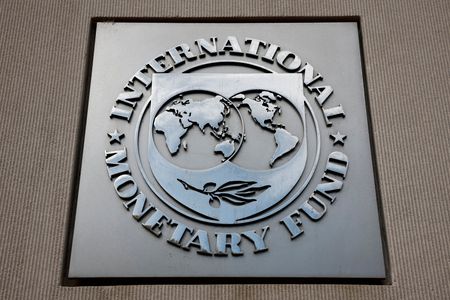By Caroline Valetkevitch
NEW YORK (Reuters) -Major stock indexes and the dollar eased on Friday after U.S. President Donald Trump unleashed his latest trade threats, recommending 50% tariffs on European Union imports from June 1 and considering a 25% tariff on any Apple iPhones made outside the U.S.
Shares of Apple ended 3% lower, while the three major U.S. stock indexes finished weaker but off session lows. European shares also ended lower.
The dollar index, which measures the greenback against a basket of currencies, hit a three-week trough. For the week, the dollar was down 1.9%, on track for its biggest weekly percentage decline since early April.
The dollar sank 1% versus the Japanese yen, while the euro rose 0.8% against the dollar.
Government bonds in the United States and Europe climbed on safe-haven buying after sustaining heavy pressure this week from rising concerns about Trump’s tax cuts and the White House’s ballooning debt pile.
Trump said in a post on his Truth Social network: “The European Union, which was formed for the primary purpose of taking advantage of the United States on TRADE, has been very difficult to deal with.”
This was the latest event in a jittery week for global markets after Moody’s downgraded the U.S. credit rating late last Friday and the U.S. House of Representatives narrowly approved Trump’s sweeping tax cuts on Thursday. The new tax-cut bill is expected to add almost $4 trillion to the U.S. federal government’s $36 trillion debt pile.
“Tariffs are back at the forefront,” said Oliver Pursche, senior vice president and advisor for Wealthspire Advisors in Westport, Connecticut.
“I think the 25% tariffs on iPhones and Apple was a little bit of a surprise. It seemed like there was going to be an exemption there, and the market is reacting more to that than the EU news, and is interpreting that as a hardening of the stance by President Trump and the administration as opposed to seeking a negotiating path.”
The Dow Jones Industrial Average fell 256.02 points, or 0.61%, to 41,603.07. The S&P 500 dropped 39.19 points, or 0.67%, to 5,802.82 and the Nasdaq Composite slipped 188.53 points, or 1.00%, to 18,737.21.
All three major U.S. stock indexes had fallen more than 1% early in the day.
For the week, the Dow lost 2.47%, the S&P 500 fell 2.61%, and the Nasdaq shed 2.48%.
MSCI’s gauge of stocks across the globe fell 2.86 points, or 0.33%, to 868.15. The pan-European STOXX 600 index fell 0.93%.
The White House paused most of the punishing tariffs Trump announced in early April against nearly every country. He left in place a 10% baseline tax on most imports, and later reduced his massive 145% tax on Chinese goods to 30%.
“Markets go through a cycle with tariffs – freak out and sell when they are announced …, freak out and buy (when) they are paused,” said Jamie Cox, managing partner at Harris Financial Group in Richmond, Virginia.
The 30-year U.S. bond yield , which on Thursday hit the highest since October 2023, fell in response to fresh tariff fears.
The yield was down 2.2 basis points at 5.042%. The yield on benchmark U.S. 10-year notes fell 3.6 basis points to 4.517%.
Thirty-year bonds have taken the brunt of the price selloff and posted the largest weekly increase in yields since April 7. Yields move the opposite direction to prices.
Gold, which has surged in recent months as economic anxiety has risen, was higher. Spot gold rose 2.14% to $3,364.74 an ounce.
Oil prices gained as U.S. buyers covered positions ahead of the three-day Memorial Day weekend.
Brent crude futures settled at $64.78 a barrel, up 34 cents, or 0.54%. U.S. West Texas Intermediate crude futures finished at $61.53, up 33 cents, or 0.54%.
(Reporting by Caroline Valetkevitch in New York, with additional reporting by Naomi Rovnick in London and Saeed Azhar in New York and Stella Qiu in Sydney; Editing by Amanda Cooper, Alex Richardson and Richard Chang)








